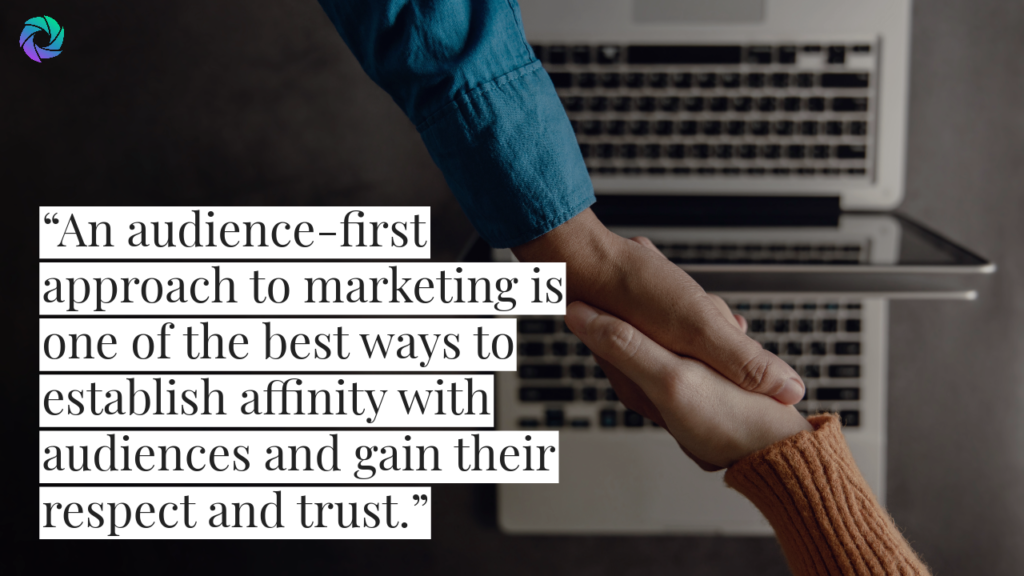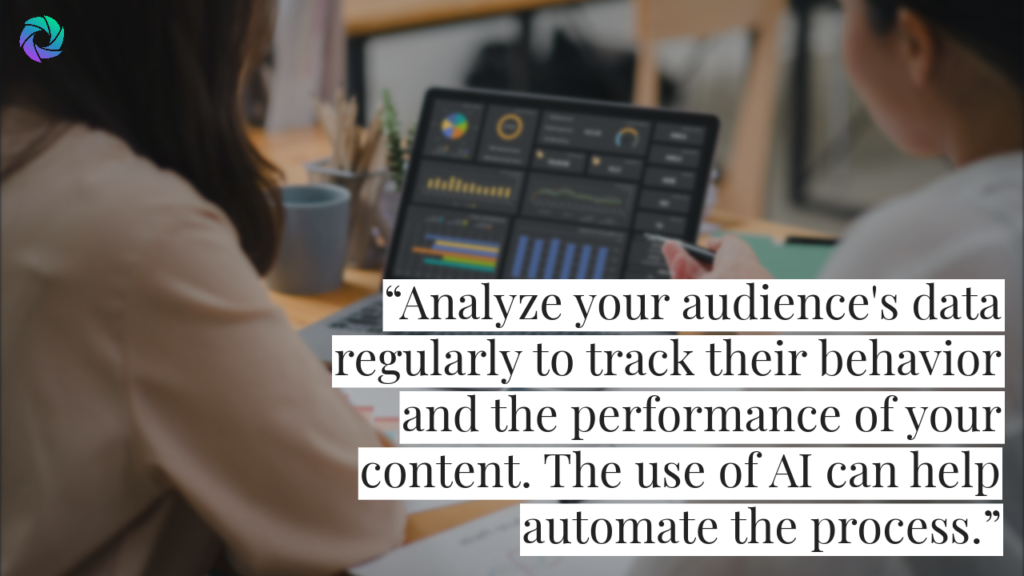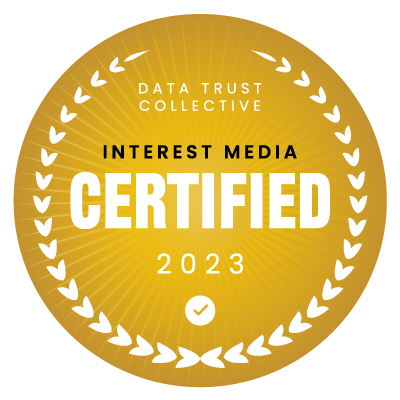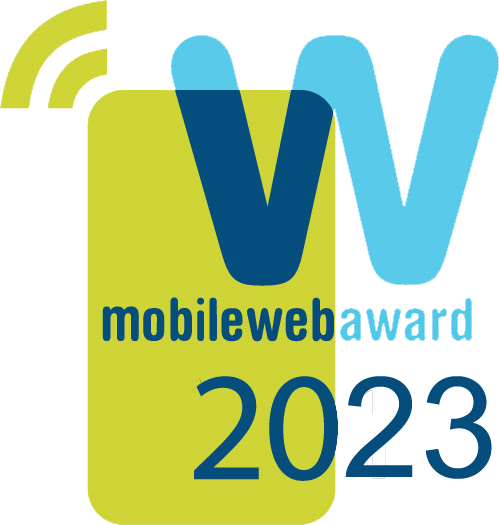
Harness the Power of Audience-Centric Marketing
- Put your target consumers at the forefront of your marketing with an audience-centric strategy.
- Learn numerous ways to ensure your campaigns are audience-centric.
- Interest Media puts the biggest brands in front of their ideal consumers with a unique, audience-centric, omnichannel solution.
In this article…
- What is Audience-Centric Marketing?
- Why is an audience-centric strategy so powerful?
- Learn how Interest Media can create an audience-centric marketing plan to reach your goals
- How to create an Audience-Centric Marketing plan
- See how to analyze your results
- Key Takeaways
What is an audience-centric approach to marketing?
As we progress through this article, we will show you specific steps and strategies for building an audience-centric approach to your marketing. But first, let’s define and gain an understanding of what audience-centric marketing is.
A single sentence definition would be: “An audience-first strategy.”
To further dissect the meaning of audience-centric, it also encompasses personalization. Rarely is it that all members of an audience have the same needs and expectations. While they may all share a common interest, for example, golf, audiences are typically widely varied from needs to knowledge.
Therefore, audience-centric marketing requires audience segmentation, then delivering to the requirements of each segment. With highly personalized marketing, it can also cater to the individual.
Next, an audience-centric also involves marketing that aims to create meaningful connections and/or conversations with your audience. Targeting your audience in a way that is personal and/or emotionally resonant.
“Podcasts, blog posts, and videos are the top three content types for generated awareness and demand,” – Content Marketing Institute
Adopting an audience-centric approach to your marketing strategies comprises a few things:
1. Understanding Your Audience
Invest time in understanding what your audience needs, demands, desires, and expects. This means not only in general but also being able to dissect and understand distinct segments of your audience. You’ll need to develop buyer personas as you identify and gain an understanding of your target audiences.
2. Audience-First Approach
Put yourself in your audience’s shoes and think from their perspective. Build campaigns that are as relevant as possible to each such segment of your audience.
3. Make Meaningful Connections with Your Audience
The most effective way of establishing a meaningful connection with your audience is to focus on emphasizing the emotional aspect of your marketing. Create campaigns that will resonate with your audience. Aim to connect on a personal level. Things change rapidly, so you may need to adapt your approach as you go. Emerging trends may require a reset and a willingness to make any necessary changes.

What makes audience-centric marketing so powerful?
Every year consumers get smarter. They become more adept at tuning out advertising. This makes it more challenging to reach them.
Further, advances in technology have transformed consumer expectations. It has become easier for them to limit which offers they want to receive and which offers they’ll respond to. Today’s consumers expect personalized offers.
However, there is a silver lining here and that is where audience-centric marketing comes in. Companies that can take an audience-first approach and deliver engaging, personalized experiences have the upper hand.
When you deliver engaging, emotionally resonant, and personalized marketing, you can establish a bond with your audience. In turn, this gains your audience’s respect and trust. Today’s consumers are seeking brands that are transparent and authentic.
Related Articles:
- Why Authenticity is Important in Marketing
- Use AI to Create Engaging Content
- Use Sweeps to Increase your Marketing ROI
- If You Need Marketing Help, Ask Taylor Swift
- How Co-Reg Can Optimize Your Lead Generation
Why Start from Scratch? Try Interest Media’s Solution to Audience-Centric Marketing
Companies that can deliver audience-centric solutions, such as Interest Media, lead the field in the ability to deliver the right offers to the right customers at the right time.
Rather than trying to build their own audience-centric marketing strategies from scratch, many publishers and advertisers are turning to Interest Media for the solutions they need. This saves time, money, and wasted effort by utilizing an effective approach that is already working.
“53% of marketers spend at least half of their budget on lead generation,” –BrightTALK
One of the factors that makes audience-centric marketing work so well is having an accurate understanding of buyer intent. This is where first-party data makes the critical difference. Interest Media’s powerful marketing engine extracts first-party data from over 25 million active consumers each month, allowing brands to connect with the precise customer segments they’re looking for.
Interest Media’s focus begins with “starting a real conversation” as opposed to merely pushing yet another ad unit.
Interest Media has the ability to put the biggest brands in front of their ideal consumers with a unique, audience-centric, omni-channel solution. Further, Interest Media is powered by an internally owned and operated network of web properties, leveraging exclusive first-party data.
If you’re looking for an audience-centric marketing solution, Interest Media has a sharp focus on user experience, diversification of campaigns, and higher earnings. They have established publisher trust by fostering engaging interactions that resonate with customers.
Start a Conversation with Our Team
Building audience-centric marketing strategies
Here are several steps to take toward building an audience-centric marketing strategy with your campaigns.
1. Identifying Your Target Audiences
Your mission out of the gate is identifying your target audiences. As you have learned, approaching your audience broadly won’t do. You must learn the factors that differentiate members of your audience from one another. Then, segment your audience accordingly.
2. Accurate Segmentation and Buyer Personas are Crucial
The next stage is ensuring that the audience segments and buyer personas you create are as accurate as possible.
It’s crucial to understand buyer needs in audience-centric marketing.
3. Understanding Audience Intent and First-Party Data
For audience-centric marketing to work effectively, one cornerstone is having an accurate understanding of audience intent for each segment. This may flow naturally out of an understanding of buyer needs. But not always. Your understanding of buyer needs could still be limited. This is where first-party data plays a critical role.
There is no better way to understand what your audience wants and needs than by asking them. Look for ways to talk to your buyers. Engaging and/or interactive content, rewards, discounts, and other incentives are methods for luring your audience into completing questionnaires.
4. Map Out Your Audience’s Intent
Ultimately, you want your audience-centric marketing strategy to focus your messaging, content, and campaigns around your audiences and their needs, not starting from a point of your offerings and product features.
You want to map out the intent of your different audience segments. One way of doing this is to map them along the buyer’s journey. However, depending on the behaviors and habits of your audience, some other method of mapping may work better for you. The ultimate focus should be to map out the intent of your audience in a way that serves their needs, not your brand’s desired outcome. This will help ensure that you deliver the right messages at the right time.
5. The Buyer’s Journey Remains Important
The buyer’s journey is an important part of audience-centric marketing. Ideally, your content should still orbit around the buyer’s journey. You’ll develop specific personalized tactics and offers at each buying stage. These may be focused on driving inquiries, lead opportunities, as well as sales.
As previously mentioned in #4 above, this isn’t a hard and fast rule. Your version of a “buyer’s journey” that fits your audience segments may have more or fewer steps than the “textbook” example. Use your data, creativity, and experimentation to find the model that works best for you.
6. Prioritize Certain Audience Segments
There is only so much marketing budget to go around. Following the Pareto Principle, 20 percent of your audience could be responsible for 80 percent of your sales. You have to put your best effort where it is going to count the most. Therefore, it will be advantageous to prioritize certain segments of your audience over others. It’s likely that for the majority of companies, this segment is going to be those with “buyer intent.”
Interest Media specializes in effective, intent-focused marketing and can save you time, expense, and effort by targeting only those consumers who have clearly demonstrated “buyer intent.”
Taking your audience-centric marketing to the next level
Having followed the tactics and techniques discussed above, there are more things that you can do to make sure your audience-centric marketing is effective. Here are a few more steps you can take to reach the next level.
1. Analyze Your Audience’s Behavioral Data
Analyzing the behavioral data of your audience segments regularly is crucial.
It’s going to take some time to fine-tune your efforts toward delivering personalized content and product recommendations. Especially if you are working on delivering hyper-personalized content–the right content, to the right user, at the right time–it’s a process.
The good news is that more and more artificial intelligence (AI) systems are coming online that can help marketers automate the process of analyzing data and tracking audience behavior.
Machine-learning and deep-learning programs can not only help understand audiences, but they can also automatically evolve with the audiences to understand them further. AI can also analyze past content performance. These analyses can help marketers with creating content that is more personalized and effective.

2. Further Developing Your Audience Personas
Especially if you are building a subscriber base of branded content, it’s crucial that you have a thorough understanding of exactly who you are targeting within your segments.
To take things to the next level, you want to go beyond demographics. The key element to doing this is having as much first-party data as possible from your audience segments. Third-party data can make an additional useful contribution and can be combined with first-party data.
There are crucial categories of information that you are looking for in developing fully realized audience personas. You want in-depth data on each of your audience member’s online behavior, needs, intent, key challenges, and expectations.
Next, the narrower you can make audience segments, the better you can hit the bull’s eye in achieving affinity.
3. Next-Level Audience Bonding
Creating a bond and relationship with your audience is a matter of understanding the culture around your audience and/or segments. You need to put yourself in their “world.” Understand their vocabulary. You’ll need to be able to absorb their milieu and speak from it. Becoming “one” with your audience is essential for crafting engaging experiences that will add value to their lives. If you can make your company or brand irreplaceable, they’ll trust you and look to you for expert opinions. You’ll have the power to influence their decisions.
4. Monitor Social Media Conversations
“As of October 2023, there are 4.95 billion active social media users in the world,” –Statista
A wealth of information about your audience can be gleaned from monitoring social media platforms. A large percentage of all people active online occurs on social media platforms.
You’ll need to learn which platforms your audiences gravitate toward the most. This can vary due to a variety of demographics within your audience, as well as due to your products and/or services. What’s important to know is that each different social media platform has its own unwritten behaviors. Language and posting styles can vary.
When monitoring social media conversations, dig deep to gain an understanding of both the nature and context of conversations. Also, look at what trends your audience follows. Many companies take advantage of trends by piggybacking off of them.
Lastly, but most importantly, make sure to analyze how your audiences react to different types of content. This will help you understand what works and what does not. Many companies have made snafus by misinterpreting trends and communicating the wrong message. Sometimes apologies will suffice. However, some companies have had to put forth significant effort to recover from social media mistakes.
Key Takeaways
◊ An audience-centric approach to marketing is an audience-first strategy. It encompasses understanding audiences and their needs and using this knowledge to deliver personalized experiences.
◊ Beginning an audience-centric marketing strategy involves deep research into understanding your audience’s needs, demands, desires, and expectations.
◊ Messaging and content created using an audience-centric approach should be relevant, and aimed at making a meaningful connection. Emphasizing emotional aspects in your messaging is one of the most effective ways.
◊ An audience-first approach to marketing is one of the best ways to establish affinity with audiences and gain their respect and trust. Consumers are looking for brands that are transparent and authentic.
◊ Interest Media helps companies avoid having to start from scratch to build an audience-centric marketing strategy. Interest Media has highly effective solutions that can save time, money, and wasted effort.
◊ The crucial steps for building an audience-centric marketing strategy from scratch require identifying your target audiences, segmentation, developing buyer personas, understanding audience intent, mapping intent across the buyer journey, the use of first-party data, and prioritizing certain audience segments.
◊ Analyze your audience’s data regularly to track their behavior and the performance of your content. The use of AI can help automate the process.
◊ Continually work to further develop your audience personas to improve your targeting using first-party data.
◊ Strengthen your bond with the audience by immersing yourself in their “world.” Look for ways to put them first by adding value to their lives.
◊ Monitor social media conversations to glean further information about your audience that can improve your audience-centric marketing efforts.












